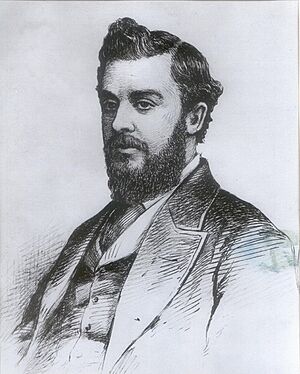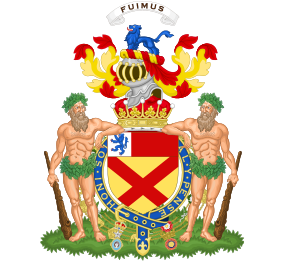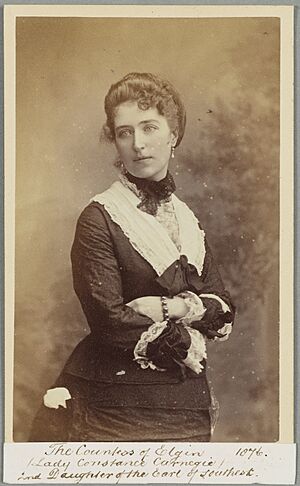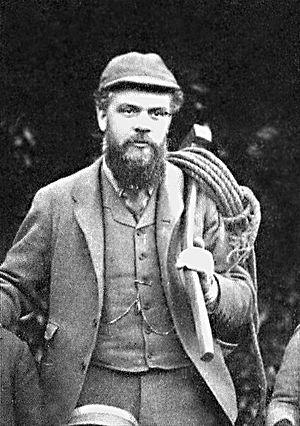Victor Bruce, 9th Earl of Elgin facts for kids
Quick facts for kids
The Earl of Elgin
|
|
|---|---|
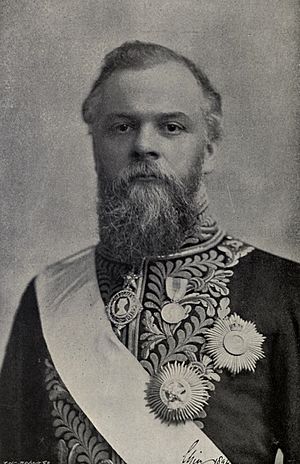
Victor Bruce, c. 1897
|
|
| Secretary of State for the Colonies | |
| In office 10 December 1905 – 12 April 1908 |
|
| Monarch | Edward VII |
| Prime Minister | Henry Campbell-Bannerman |
| Preceded by | Alfred Lyttelton |
| Succeeded by | The Earl of Crewe |
| Viceroy and Governor-General of India | |
| In office 11 October 1894 – 6 January 1899 |
|
| Monarch | Victoria |
| Preceded by | The Marquess of Lansdowne |
| Succeeded by | The Lord Curzon of Kedleston |
| Personal details | |
| Born | 16 May 1849 Montreal, Canada East, Province of Canada |
| Died | 18 January 1917 (aged 67) Dunfermline, Fife, United Kingdom |
| Nationality | British |
| Political party | Liberal |
| Spouses | (1) Lady Constance Mary (2) Gertrud Lilian Ashley Sherbrooke; d. 1971 |
| Children | 12, including Edward Bruce, 10th Earl of Elgin |
| Parents | James Bruce, 8th Earl of Elgin Lady May Louisa Lambton |
| Alma mater | Balliol College, Oxford |
Victor Alexander Bruce, 9th Earl of Elgin, also known as Lord Bruce until 1863, was an important British politician. He was born on May 16, 1849, and passed away on January 18, 1917. He held a very important job as the Viceroy of India from 1894 to 1899.
Later, in 1902, he was asked by Prime Minister Arthur Balfour to lead a special investigation. This group, called the Elgin Commission, looked into how the Second Boer War was fought. It was the first time such an investigation happened in the British Empire. The commission even traveled to South Africa to talk to soldiers who had fought in the battles. It was also the first time the British Army officially listened to ordinary soldiers, not just officers.
Contents
Early Life and Education
Victor Bruce was born in Montreal, which was then called Canada East. His father, James Bruce, 8th Earl of Elgin, was the Governor-General of Canada at that time. His mother was Lady May Louisa.
Victor went to school at Glenalmond, Eton, and then Balliol College, Oxford university.
Political Journey
Victor Bruce joined the Liberal Party in politics. He held a few government jobs early in his career. For example, he worked as the Treasurer of the Household and as the First Commissioner of Works in 1886.
Serving as Viceroy of India
Following in his father's footsteps, Victor Bruce became the Viceroy of India in 1894. The Viceroy was like the highest British official in India. He was in charge of the British government there.
Lord Elgin didn't really enjoy all the fancy ceremonies that came with being Viceroy. He once said that India was super important to the British Empire. He believed that if Britain lost India, the Empire would be in big trouble.
During his time as Viceroy, there was a terrible famine in India. Many people died because of it. His time in India was also known for some local uprisings, like the Afridi frontier risings in 1897–1898.
The Elgin Commission
After his time in India, Lord Elgin returned to England in 1899. He was given a special honor and became a Knight of the Garter.
From 1902 to 1903, he led the commission that investigated the Second Boer War. This commission looked at how the war was managed. They also discussed how cavalry (soldiers on horseback) should be used in future wars. Some wanted cavalry to charge with swords, while others thought they should fight on foot with guns.
Colonial Secretary Role
When the Liberal Party came back into power in 1905, Lord Elgin became the Secretary of State for the Colonies. This meant he was in charge of all the British colonies around the world. Winston Churchill, who later became a famous Prime Minister, worked under him.
Lord Elgin preferred a careful approach in his role. He retired from public life in 1908.
Special Honors
Lord Elgin received several important honors during his life. He was made a Knight Grand Commander of the Order of the Star of India and the Order of the Indian Empire when he became Viceroy in 1894. In 1899, he was made a Knight of the Order of the Garter.
In 1902, he was given the "freedom of the city" of St Andrews in Scotland. This was to thank him for his public service, especially for his work as Viceroy of India.
Family Life
Lord Elgin married Lady Constance Mary in 1876. She was the daughter of James Carnegie, 9th Earl of Southesk. They had eleven children together: six sons and five daughters.
Their children were:
- Lady Elizabeth Mary Bruce (born 1877)
- Lady Christina Augusta Bruce (born 1879)
- Lady Constance Veronica Bruce (born 1880)
- Edward James Bruce, 10th Earl of Elgin (born 1881)
- Hon. Robert Bruce (born 1882)
- Hon. Alexander Bruce (born 1884)
- Lady Marjorie Bruce (born 1885)
- Colonel Hon. David Bruce (born 1888)
- Lady Rachel Catherine Bruce (born 1890)
- Captain Hon. John Bernard Bruce (born 1892)
- Hon. Victor Alexander Bruce (born 1897)
After Lady Elgin passed away in 1909, Lord Elgin married Gertrude Lilian in 1913. They had one son, Bernard Bruce, who was born after his father's death.
Later Years and Legacy
Lord Elgin passed away at his family home in Dunfermline in January 1917. He was 67 years old. His oldest son, Edward, took over his titles.
Kincardine Whisky
In 2016, a special whisky called Kincardine whisky was created. It was made to honor Lord Elgin's achievements, especially his time as Viceroy in India. The whisky used photos from the Bruce family's old collections.
Kincardine whisky was a mix of Indian single malt whisky and Scotch whisky from Scotland. Only 800 bottles were made. Interestingly, Alex Bruce, who helped create this whisky, is Lord Elgin's great-grandson.
See also
- Famine in India


